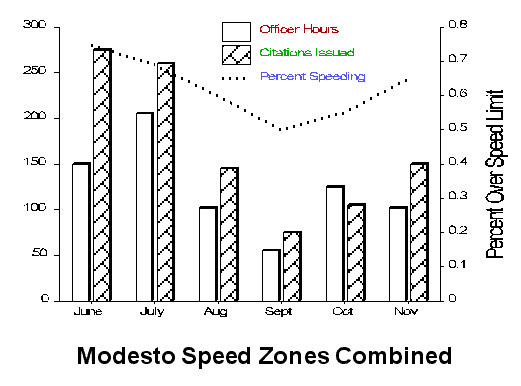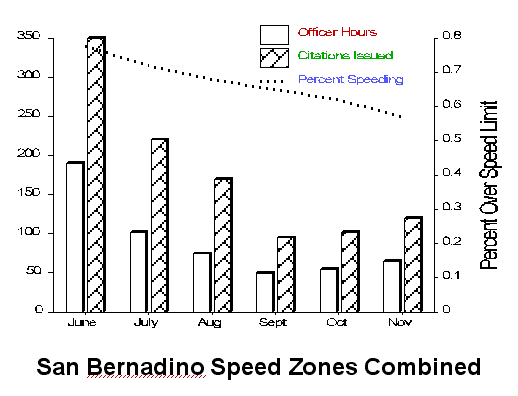















Traffic Tech #109: Municipal Speed Enforcement Programs Evaluated |
|---|
|

Number 109 November 1995
MUNICIPAL SPEED ENFORCEMENT PROGRAMS EVALUATED
When a municipal police department begins a concentrated speed enforcement program, we can expect to see more speeding citations. The National Highway Traffic Safety Administration (NHTSA) wanted to know whether cracking down on speeders would also reduce the number of crashes that were related to speed and whether this kind of traffic enforcement has a deterrent effect on criminal activity in the vicinity of the enforcement.
Three California communities participated in a six month study. The police departments in Modesto and San Bernadino conducted speed enforcement programs in 6 special enforcement zones within each community. A third community refrained from implementing any special traffic enforcement effort during this time and served as the comparison site. Officers in the two study communities spent, on average, about 8 hours each week in each of the special enforcement zones conducting radar and laser-assisted speed enforcement.
To compliment the enforcement programs, both Modesto and San Bernadino organized traffic safety program support committees to elevate public awareness of the special enforcement efforts. The committees were composed of the police manager, local leaders, and concerned citizens and were chaired by emergency department physicians. The campaigns included press conferences, posters, brochures, supermarket drop-ins, public speakers, bus bench display advertising, media events, and TV and radio public service announcements.
The contractor collected data on crashes, speed samples, and crime from each of the police departments and a statewide reporting system. They looked at the incidence of injury, fatal, and property damage only crashes in which unsafe speed, following-too-closely, or right-of-way violation was the primary collision factor.


Speed Related Crashes Decline
In both study sites, speed related crashes declined 11.3 and 1.1 percent, while increasing 3.4 percent in the comparison community. The reduction in speed related crashes was statistically significant in one of the experimental communities. During this time, unobtrusive measures of vehicle speed found that the number of vehicles exceeding the limits declined 19 and 10 percent in the two study sites. In the comparison community, where no special enforcement occurred, the number of speeders declined by only 3 percent.
Certain Crimes Decline
The FBI categorizes crimes as Part I and Part II. The 8 Part I crimes are the more serious and include homicide, rape, robbery, burglary and breaking or entering, larceny-theft, arson, and motor vehicle theft. The list of Part II crimes is more extensive and includes forgery, vandalism, weapons carrying, and drug abuse violations. Both Part I and Part II crimes were analyzed in this study.
Overall, the more serious Part I crimes declined by 8 percent in the special enforcement zones of one of the study communities, and by 1 percent in the other. Part I crimes increased by 4 percent in the comparison control zones. None of the changes were statistically significant.
Looking at larceny-theft crimes only, however, both study communities showed statistically significant declines. Larceny is the only Part I crime that is equally likely to occur during daylight hours as at night (when the special enforcement was conducted). Larceny and theft declined 11 and 12 percent, compared to a statewide decline of only 1.7 percent and an increase of 4 percent in the comparison community. In addition, Part II crimes declined by 9 percent in one of the study communities and this change from the same six-month period one year earlier was statistically significant. Similar Part II crime data could not be obtained for the other study community. Part II crimes increased by 8 percent in the comparison community.
Traffic enforcement stops conducted during the study resulted in more than 2,000 arrests for offenses ranging from assault to misdemeanor and felony warrants.
Municipal speed enforcement programs can have positive effects on public opinion, traffic safety, and crime. The benefits obtained during the current study include:
For a copy of the 70 page report, Experimental Evaluation of Municipal Speed Enforcement Program, contact Police Traffic Services, NHTSA, NTS-41, 400 Seventh Street S.W., Washington, DC 20590, or send a fax to (202) 366-7721.
U.S. Department of Transportation
National Highway
Traffic Safety
Administration
400 Seventh Street, S.W. NTS-33
Washington, DC 20590
Traffic Tech is a publication to disseminate information about traffic safety programs, including evaluations, innovative programs, and new publications. Feel free to copy it as you wish.
If you would like to receive a copy contact:
Linda Cosgrove, Ph.D., Editor,
Evaluation Staff Traffic Safety Programs
(202) 366-2759
